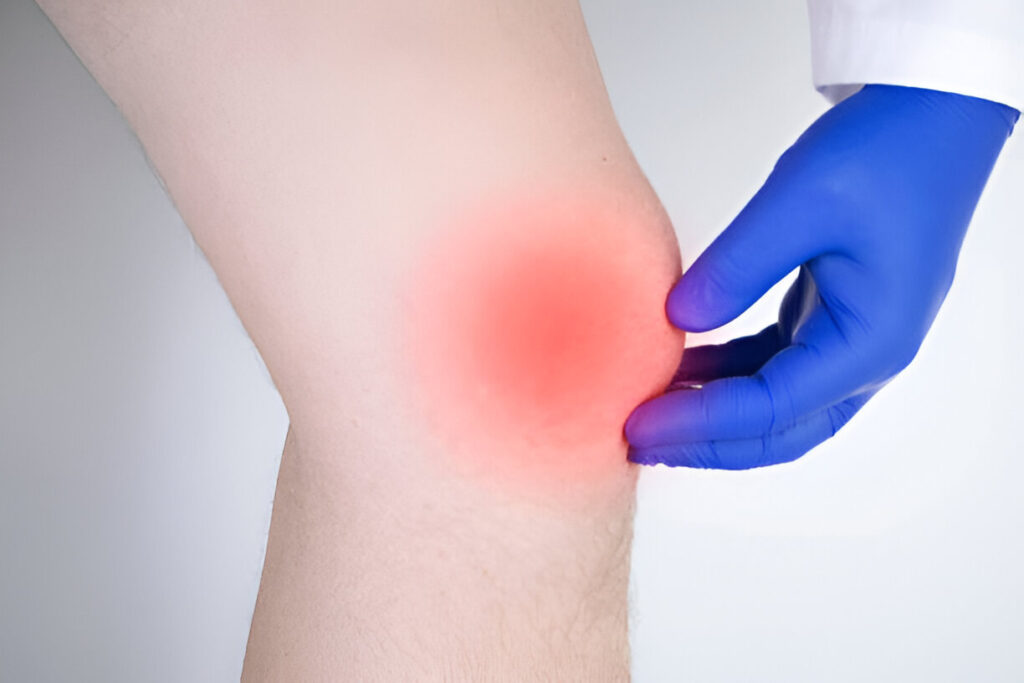Lyme disease is the most common tick-borne illness in North America and Europe, caused by the bacterium Borrelia burgdorferi. Early symptoms include fever, fatigue, and the hallmark bull’s-eye rash. Many patients also experience joint inflammation weeks or months later. This condition, known as Lyme arthritis, often targets the knees and other large joints, resulting in swelling, stiffness, and pain that can persist long after the initial infection.
Understanding why Lyme disease joint pain occurs and how to manage it is key to regaining mobility and protecting long-term joint health.
Why Lyme Disease Causes Joint Pain
The Lyme disease joint pain isn’t just discomfort, it’s a result of the body’s complex immune response to Borrelia burgdorferi. Once this spiral-shaped bacterium enters the bloodstream through a tick bite, it can spread to various tissues, including the joints.
Here’s how it works:
- Direct Infection of Joints: B. burgdorferi invades the synovial membrane (the lining of joints), causing localized inflammation and fluid buildup.
- Immune System Overdrive: The body mounts a defense, releasing pro-inflammatory cytokines that can damage joint tissues.
- Autoimmune Reaction: In some cases, the immune system continues attacking joint tissues even after the bacteria are gone—a condition known as post-treatment Lyme disease syndrome (PTLDS).
Lyme Arthritis vs. Other Types of Arthritis
Lyme arthritis differs significantly from osteoarthritis or rheumatoid arthritis:
| Feature | Lyme Arthritis | Osteoarthritis | Rheumatoid Arthritis |
|---|---|---|---|
| Cause | Bacterial infection | Wear-and-tear | Autoimmune disease |
| Pain Pattern | Migratory, often asymmetric | Localized, symmetrical | Symmetrical, chronic |
| Swelling | Often severe | Mild to moderate | Persistent |
| Onset | Weeks/months post-tick bite | Gradual | Rapid or slow |
According to Johns Hopkins Lyme Disease Research Center, about 60% of untreated patients develop Lyme arthritis within months of infection, especially if early symptoms go unnoticed.
(Source: Johns Hopkins Lyme Arthritis)
Symptoms of Lyme Disease Joint Pain
Patients with Lyme disease symptoms in joints often report the following:
- Sudden or severe knee pain
- Noticeable joint swelling, especially in the knees, elbows, or ankles
- Joint stiffness that worsens after rest
- Migratory pain—pain that shifts between joints
- Fatigue and general malaise
- Episodes of pain that come and go
Early vs. Late-Onset Symptoms
- Early-stage Lyme joint pain: Mild stiffness or occasional aches within weeks of infection.
- Late-stage Lyme arthritis: More persistent swelling and pain, often appearing 3–6 months post-infection.

Diagnosis
Diagnosing Lyme disease joint pain involves both clinical assessment and laboratory testing.
1. Blood Tests
- ELISA (Enzyme-Linked Immunosorbent Assay): Detects antibodies against Borrelia.
- Western Blot: Confirms ELISA results and checks for specific Lyme proteins.
Both tests may be negative early in the disease, so repeat testing or clinical judgment is crucial.
2. Physical Examination
Doctors look for:
- Swollen, warm joints (especially knees)
- History of tick exposure or prior Lyme symptoms
- Pattern of joint pain (asymmetrical or migratory)
3. Ruling Out Other Conditions
To ensure accurate diagnosis, conditions like rheumatoid arthritis, lupus, or reactive arthritis must be excluded.
Why Early Diagnosis Matters: Delayed treatment can result in chronic joint pain after Lyme, which may persist for months or years, even after the infection is cleared.
Treatment Options
1. Antibiotics for Early Lyme Arthritis
- Doxycycline (100 mg twice daily for 28 days)
- Amoxicillin or Cefuroxime (for those allergic to doxycycline)
Most patients see improvement within 1–2 weeks of starting antibiotics.
2. Chronic or Persistent Lyme Arthritis
Some patients may need a second course of antibiotics or additional therapies if symptoms persist.
- NSAIDs: Reduce inflammation and pain (e.g., ibuprofen, naproxen)
- DMARDs: For immune-mediated joint inflammation (e.g., methotrexate)
- Biologics: Reserved for severe autoimmune cases under rheumatologist supervision
3. Complementary Therapies
- Physical therapy: Restores joint function and flexibility
- Anti-inflammatory diets: Focus on omega-3s, turmeric, berries, and leafy greens
See our article: Best Anti-Inflammatory Foods for Joints - CBD oil or topical creams: May ease pain perception
- Turmeric supplements: Natural anti-inflammatory agent
Related: Natural Remedies for Joint Inflammation
⚠️ Avoid “miracle cures” like unproven detox kits, ozone therapy, or long-term unprescribed antibiotics, which can do more harm than good.
Prevention & Long-Term Joint Protection
1. How to Avoid Tick Bites
- Wear long sleeves and pants in grassy or wooded areas
- Use EPA-approved insect repellents (DEET, picaridin)
- Shower and check for ticks within 2 hours of being outdoors
- Remove ticks properly with tweezers—not fingers

2. Post-Infection Joint Care
To protect against Lyme disease joint pain, you should follow these steps;
- Stay active with low-impact exercises (swimming, yoga, cycling)
- Hydrate well to support synovial fluid production
- Consider supplements like:
- Glucosamine and chondroitin: Support cartilage
- Omega-3 fatty acids: Reduce inflammation
- Vitamin D and calcium: Support bone and joint health
FAQs
Is Lyme joint pain permanent?
Not usually. Most people recover with proper treatment, but about 10–20% may develop chronic symptoms (PTLDS). Rehabilitation and inflammation management are key.
Can Lyme arthritis recur after treatment?
Yes, especially if the infection wasn’t fully eradicated or if an autoimmune response lingers. Recurrence is rare after complete antibiotic therapy, but some may need extended care.
What joints are most affected by Lyme disease?
The knees are most commonly affected, followed by the ankles, elbows, wrists, and shoulders. Pain is usually asymmetrical and may move between joints.
Final Thoughts
Joint pain from Lyme disease can be frustrating, debilitating, and difficult to manage—but with early diagnosis and targeted treatment, recovery is entirely possible. Whether you’re newly infected or living with chronic joint pain after Lyme, this guide offers a roadmap for relief and prevention.
👉 If you’re unsure about your joint symptoms or suspect Lyme arthritis, consult a rheumatologist or infectious disease specialist. Your joints—and your health—are worth protecting.